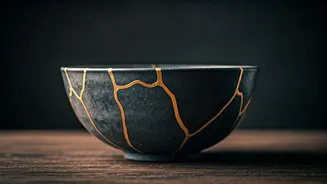Ancient Japanese Origins
The genesis of Kintsugi can be traced back to the Muromachi period of Japan, which spanned from the 14th to the 16th century. It originated when the shogun,
or military leader, broke his precious tea bowls. Instead of discarding them, he decided to have them repaired. This repair was not done in a way that tried to hide the damage but instead embraced it. This act of repair was then elevated into an art form. The craftsmen used lacquer, often mixed with precious metals like gold, to mend the broken pieces. This technique transformed the flaws into features, emphasizing the history and uniqueness of each piece. This practice demonstrated a deep respect for the object's history and a rejection of the idea of disposability. The philosophy of Kintsugi quickly spread, representing resilience, embracing imperfections, and finding beauty in the incomplete, thus influencing Japanese aesthetics and culture.
Kintsugi's Golden Techniques
The meticulous process of Kintsugi involves a variety of techniques that reflect the artistry and the attention to detail. Initially, artisans carefully gather the broken pieces of the pottery, ensuring they have everything needed for the mending. The most traditional method uses a lacquer made from the sap of the Urushi tree. This lacquer is exceptionally strong and is ideally suited for holding pieces together. Gold, silver, or platinum is then mixed with the lacquer to fill the cracks and create the characteristic golden seams. This stage requires patience and skill as the lacquer needs time to cure. The application of gold can vary, sometimes involving fine dust to create a delicate effect or thicker applications for a bold statement. Further steps may include careful polishing to achieve the desired luster and smoothness. Various Kintsugi techniques have evolved over time, yet each underscores the core principle of celebrating the history and uniqueness of each piece. The entire process requires a deep level of craftsmanship and appreciation for the object and the process itself.
Aesthetic & Philosophical Rewards
Kintsugi offers benefits that transcend mere aesthetics, resonating deeply on a philosophical level. From an aesthetic standpoint, the golden repairs create a unique and visually striking contrast. The contrast between the broken ceramic and the gleaming gold enhances the object's beauty, making it more distinctive and valuable. Each piece repaired is transformed into a unique work of art, a testament to its history and the craftsmanship involved. At a deeper level, Kintsugi embodies the philosophy of Wabi-Sabi, which appreciates beauty in imperfection, impermanence, and simplicity. This practice encourages us to accept the marks of time and experience. The act of repairing and celebrating the damage symbolizes resilience and the ability to find beauty in adversity. This has implications far beyond the art form itself, fostering a mindset of acceptance, patience, and appreciation for the transient nature of life, which brings solace and strength.
Modern Interpretations Embrace
While Kintsugi has deep historical roots, it has seen a resurgence in contemporary art and design. Modern interpretations of Kintsugi vary, and they often blend traditional techniques with more modern materials and styles. Artists experiment with various materials and colors beyond gold, using silver, bronze, or even colorful epoxy resins to create striking visual effects. Some contemporary practitioners adapt the technique to broken objects beyond pottery, extending its principles to sculptures, furniture, and even jewelry. This evolution reflects Kintsugi's adaptability and enduring appeal. The modern approach also extends into the realm of digital art and design, where the concepts of repair and transformation inspire creative expression. This continuing evolution shows that Kintsugi is more than just a technique; it is a philosophy that can be applied to many aspects of life, offering a unique perspective on resilience, beauty, and the embrace of imperfections, still relevant today.














